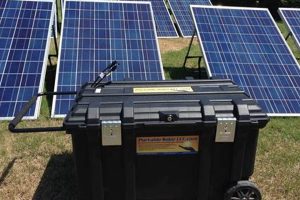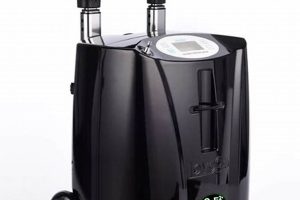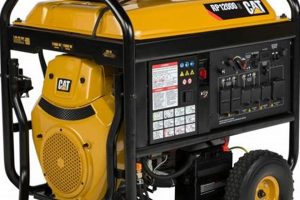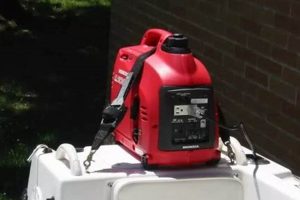A transfer switch safely connects a portable generator to a home’s electrical system. It isolates the house from the utility grid during generator operation, preventing dangerous backfeeding that could harm utility workers. For instance, a homeowner might use one to power essential circuits during a power outage.
This device ensures safe, reliable power delivery during outages, protecting both appliances and the broader electrical grid. By managing the flow of electricity, it avoids damage from voltage fluctuations and prevents the generator from overloading. The development of these safety devices reflects increasing reliance on generators for backup power, driven by factors like aging infrastructure and more frequent extreme weather events.
Understanding the function and importance of this equipment provides a foundation for exploring related topics such as generator sizing, proper installation procedures, and legal requirements for connection to home circuits.
Safe and Effective Generator Use
Proper use of a transfer switch and portable generator is crucial for safety and efficiency. The following tips provide guidance for optimal performance and risk mitigation.
Tip 1: Professional Installation: Employ a qualified electrician to install the transfer switch. This ensures adherence to electrical codes and safe integration with the home’s electrical system.
Tip 2: Correct Sizing: Select a transfer switch rated for the generator’s output. An undersized switch can overheat and create a fire hazard.
Tip 3: Circuit Prioritization: Determine essential circuits (refrigerator, lights, heating) and connect them to the transfer switch for prioritized power during outages.
Tip 4: Regular Testing: Periodically test the generator and transfer switch to ensure they function correctly. Simulate an outage to verify proper switchover and power delivery.
Tip 5: Proper Grounding: Ensure the generator and transfer switch are properly grounded to prevent electrical shocks and equipment damage.
Tip 6: Fuel Safety: Store fuel in approved containers in a well-ventilated area away from ignition sources. Never refuel a hot generator.
Tip 7: Load Management: Avoid overloading the generator. Stagger the startup of appliances to prevent exceeding the generator’s capacity.
Adhering to these guidelines will ensure the safe and effective use of a portable generator and transfer switch, providing reliable backup power when needed.
By understanding and implementing these practices, homeowners can confidently rely on their backup power systems during emergencies, minimizing disruption and maximizing safety.
1. Safety
Safety is paramount when utilizing a portable generator and transfer switch. A primary safety concern involves preventing backfeeding, where electricity flows from the generator back into the utility grid. This poses a lethal danger to utility workers repairing downed power lines. A transfer switch isolates the home’s electrical system from the grid during generator operation, eliminating this risk. For example, if a lineman assumes a power line is de-energized during an outage, unknowingly encountering backfed power from a nearby generator could result in electrocution. The transfer switch acts as a critical safeguard against such incidents.
Further safety considerations include proper grounding to prevent electrical shock and fire hazards from overloaded circuits. Generators produce significant power; connecting them directly to household outlets without a transfer switch can overwhelm wiring, potentially leading to fires. Additionally, proper ventilation is crucial when operating a generator to prevent carbon monoxide poisoning. Operating the generator outdoors, away from open windows and doors, significantly reduces this risk. These safety practices, alongside professional installation of the transfer switch, are crucial for protecting both individuals and property.
In summary, a transfer switch is essential for safe generator operation. Preventing backfeeding, ensuring proper grounding, and following safe operating procedures mitigate significant risks. Understanding and adhering to these safety measures enables effective utilization of backup power while safeguarding individuals and the electrical grid.
2. Installation
Installation of a reliance portable generator transfer switch is a critical process directly impacting the system’s safety, reliability, and code compliance. Incorrect installation can negate the safety benefits of the transfer switch, potentially leading to backfeeding, equipment damage, or fire hazards. For example, improper wiring could bypass the isolation function of the switch, allowing the generator to energize the utility grid during operation, posing a serious risk to utility workers. Furthermore, loose connections can cause overheating and potential fire hazards, while inadequate grounding increases the risk of electrical shock. Therefore, installation must adhere strictly to local electrical codes and manufacturer instructions.
Professional installation by a qualified electrician is highly recommended. An electrician possesses the necessary expertise to assess the home’s electrical system, select the appropriate transfer switch for the generator’s capacity, and ensure proper integration with the existing circuits. They understand grounding requirements, wiring configurations, and local code compliance, minimizing the risk of errors. Consider a scenario where a homeowner attempts a DIY installation and miswires the neutral and ground conductors. This seemingly minor error can create dangerous voltage imbalances, potentially damaging sensitive electronics and increasing shock risks. Professional installation mitigates such risks.
In summary, proper installation is fundamental to the safe and effective operation of a reliance portable generator transfer switch. Professional installation ensures compliance with safety standards and maximizes the system’s protective capabilities, mitigating risks like backfeeding, fire hazards, and electrical shocks. This critical step ensures the transfer switch functions as intended, providing reliable backup power during outages while safeguarding individuals and the electrical grid.
3. Capacity
Capacity, referring to the power output rating of both the generator and the transfer switch, is a critical factor in a reliance portable generator transfer switch system. The transfer switch must possess a capacity rating equal to or greater than the generator’s output. An undersized transfer switch presents a significant fire hazard due to potential overheating from current exceeding the switch’s design limits. For instance, connecting a 7,000-watt generator to a 5,000-watt transfer switch could lead to overheating, potentially melting insulation and igniting surrounding materials. Conversely, an oversized transfer switch, while not a safety hazard, represents an unnecessary expense. Therefore, careful consideration of generator output and corresponding transfer switch capacity is essential.
Furthermore, the transfer switch’s capacity dictates the number and type of circuits that can be powered during generator operation. Attempting to power loads exceeding the transfer switch’s capacity will trip the breaker, interrupting power supply. For example, a homeowner with a 5,000-watt transfer switch might be able to power essential appliances like a refrigerator, furnace blower, and several lights, but adding high-wattage appliances like a well pump or electric range could overload the system. Therefore, careful planning and load management are crucial. Calculating the wattage requirements of essential circuits aids in selecting an appropriately sized generator and transfer switch combination, ensuring reliable backup power for critical loads during outages.
In summary, understanding transfer switch capacity is crucial for safe and effective generator operation. Matching the transfer switch capacity to the generator output prevents overheating and fire hazards. Additionally, understanding the load limitations of the transfer switch enables effective power management during outages, ensuring critical circuits receive power while preventing overload. This careful consideration of capacity is essential for maximizing the benefits of a reliance portable generator transfer switch system.
4. Connection
Connection, in the context of a reliance portable generator transfer switch, refers to the precise and safe integration of the generator, the transfer switch itself, and the home’s electrical circuits. This encompasses both the physical wiring and the logical arrangement of circuits designated for backup power. Incorrect connections can lead to a range of hazardous outcomes, from negating the safety features of the transfer switch to causing equipment damage or even fires. For instance, if the generator’s output is improperly connected to the transfer switch’s input, the system may fail to isolate the house from the grid, leading to the dangerous backfeeding phenomenon. Alternatively, connecting too many circuits to the transfer switch can overload the generator, resulting in damage to both the generator and connected appliances. Therefore, precise connection is crucial for both safety and functionality. The connection process also includes the proper bonding of grounding conductors to ensure a safe return path for fault currents, preventing electrical shocks.
Furthermore, connection involves strategically selecting which circuits receive power from the generator during an outage. This requires prioritizing essential circuits, such as those powering refrigerators, heating systems, or medical equipment. Non-essential circuits, like those for entertainment systems or outdoor lighting, should be excluded to avoid overloading the generator. For example, during a prolonged outage, a homeowner might prioritize powering the refrigerator, a few essential lights, and a furnace blower, while foregoing the use of less critical appliances like a clothes dryer or dishwasher. This judicious allocation of power ensures the generator’s capacity is effectively utilized to maintain essential functions during the outage. The connection process, therefore, represents not just a physical linkage but a strategic allocation of power resources.
In summary, the connection aspect of a reliance portable generator transfer switch encompasses both the physical wiring and the logical allocation of power. Correct connection procedures, executed by a qualified electrician, are paramount for safety, ensuring grid isolation, preventing equipment damage, and enabling the effective prioritization of essential circuits during power outages. Understanding the significance of proper connection empowers homeowners to utilize their backup power systems effectively and safely, maximizing their resilience during emergencies.
5. Operation
Operation of a reliance portable generator transfer switch encompasses the procedures and practices involved in safely and effectively utilizing the system during a power outage. Understanding these procedures is crucial for maximizing the system’s benefits while mitigating potential risks. Correct operation ensures the safe transition from utility power to generator power, prevents damage to connected appliances, and maintains the integrity of the electrical grid.
- Starting and Stopping the Generator:
Proper generator operation begins with following manufacturer instructions for starting and stopping. Before starting, ensure the generator is outdoors in a well-ventilated area to prevent carbon monoxide buildup. After starting, allow the generator to stabilize before engaging the transfer switch. When utility power is restored, first transfer the load back to the utility source, then allow the generator to cool down before stopping it. This controlled sequence minimizes strain on both the generator and connected appliances, prolonging their lifespans.
- Engaging the Transfer Switch:
Once the generator is running smoothly, the transfer switch is engaged to redirect power from the utility grid to the generator. This isolates the house from the grid, preventing backfeeding. Confirming successful switchover by checking the status indicator on the transfer switch is vital before attempting to use any appliances. This ensures the generator is supplying power correctly and the house is isolated from the utility lines. Incorrect engagement or disengagement can damage appliances or create safety hazards.
- Load Management:
Effective load management is essential during generator operation. Avoid exceeding the generator’s rated wattage. Prioritize essential circuits and stagger the startup of appliances to prevent overloading. For example, start the refrigerator first, then add lights, and finally, other essential appliances like a furnace blower. Excessive load can damage the generator, trip breakers, or even cause a fire. Careful management ensures continuous power to critical systems without exceeding the generator’s capacity.
- Monitoring and Maintenance:
Regular monitoring of the generator during operation includes checking fuel levels, oil pressure, and engine temperature. Adhering to the manufacturer’s recommended maintenance schedule ensures optimal performance and prolongs the generator’s lifespan. Neglecting maintenance can lead to decreased efficiency, malfunctions, and even premature failure, potentially leaving the homeowner without backup power during an extended outage. Routine maintenance, such as oil changes and air filter replacements, is essential for reliability.
In conclusion, proper operation of a reliance portable generator transfer switch is crucial for ensuring safety, maximizing efficiency, and prolonging the lifespan of the equipment. Understanding and following these operational procedures empowers homeowners to confidently utilize their backup power systems during outages, minimizing disruption and enhancing safety.
Frequently Asked Questions
This section addresses common inquiries regarding reliance portable generator transfer switches, providing concise and informative responses.
Question 1: Why is a transfer switch necessary when using a portable generator?
A transfer switch is essential for safety. It isolates the home’s electrical system from the utility grid, preventing backfeeding, a dangerous condition that can harm utility workers. It also protects household appliances from voltage fluctuations.
Question 2: What size transfer switch is needed for a specific generator?
The transfer switch capacity must match or exceed the generator’s power output. Consulting an electrician ensures proper sizing based on the generator’s specifications and intended load.
Question 3: Can a homeowner install a transfer switch themselves?
While possible in some jurisdictions, professional installation by a qualified electrician is strongly recommended. Incorrect installation can compromise safety and violate electrical codes, leading to potential hazards.
Question 4: Which circuits should be connected to the transfer switch?
Essential circuits, such as those powering refrigerators, lighting, and heating systems, should be prioritized. An electrician can help determine the optimal configuration based on the generator’s capacity and household needs.
Question 5: How often should a transfer switch be tested?
Regular testing, at least annually, is recommended to ensure proper functionality. Simulating a power outage verifies correct switchover and power delivery to designated circuits.
Question 6: What safety precautions should be taken when operating a generator with a transfer switch?
Operate the generator outdoors in a well-ventilated area to prevent carbon monoxide poisoning. Never refuel a hot generator. Adhere to load limitations to avoid overloading the generator and transfer switch.
Understanding these key aspects of reliance portable generator transfer switches ensures safe and effective operation, providing reliable backup power during outages.
For further information or specific inquiries, consult a qualified electrician or refer to the manufacturer’s documentation.
Conclusion
Reliance portable generator transfer switches represent a crucial component of effective backup power systems. Exploration of this topic has highlighted the importance of proper installation, capacity matching, circuit prioritization, and adherence to safety protocols. Safe operation requires a thorough understanding of connection procedures, load management, and regular maintenance. Neglecting these considerations can compromise safety, damage equipment, and render the system ineffective during critical outages.
Investment in a properly installed and maintained reliance portable generator transfer switch system provides peace of mind during unforeseen power disruptions. Prioritizing safety and adhering to best practices ensures reliable backup power, safeguarding both households and the broader electrical grid. Diligence in these areas contributes significantly to enhanced preparedness and resilience in the face of power outages.






